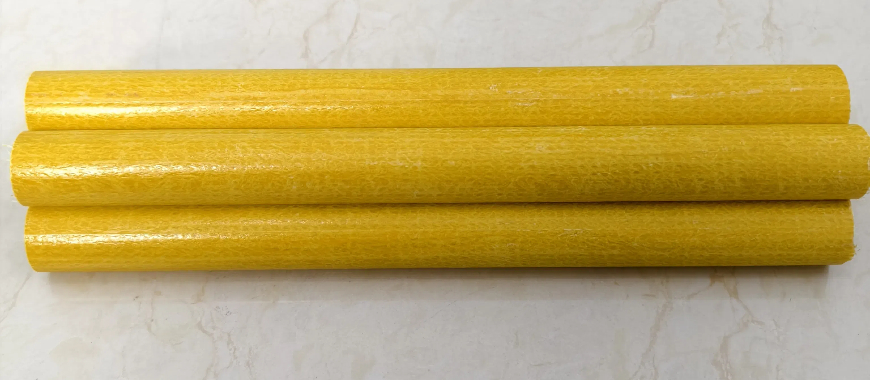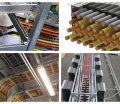
Fiberglass PVC has emerged as a highly versatile material, widely used in construction and industrial applications. This unique composite combines the durability and strength of fiberglass with the flexibility and lightweight nature of PVC, making it suitable for diverse projects such as piping, roofing, and structural panels. Fiberglass PVC is particularly valued for its resistance to corrosion, weather, and chemicals, which enhances its performance in demanding environments.
When comparing fiberglass PVC to traditional fiberglass, it offers better flexibility and easier handling. On the other hand, compared to regular PVC, fiberglass PVC boasts superior strength and durability, especially in high-stress or high-temperature conditions. These advantages position fiberglass PVC as a cost-effective and efficient choice for modern industrial needs.
What is Fiberglass PVC?
Definition and Composition
Fiberglass PVC is a composite material that merges the unparalleled strength of fiberglass with the flexibility and versatility of PVC. This combination results in a highly durable material that is lightweight yet capable of withstanding significant stress and environmental challenges. Fiberglass PVC retains the impact resistance and chemical stability of fiberglass while benefiting from PVC’s easy handling and adaptability. This synergy makes fiberglass PVC ideal for applications requiring structural integrity and long-lasting performance, such as in construction and industrial systems.
Manufacturing Process
Key Points on the Production of Fiberglass PVC:
Blending of Materials:
- Fiberglass strands are blended with PVC material to create a base composite.
- A specialized fiberglass PVC resin is used to bond the materials.
Role of Fiberglass PVC Resin:
- Enhances the overall durability of the composite.
- Ensures flexibility and weather resistance for the final product.
Layering Process:
- Layers of fiberglass are embedded within a PVC matrix during production.
- This creates a structure that is both strong and lightweight.
Material Properties:
- Resistant to cracking and corrosion.
- Can withstand extreme temperature variations.
Applications:
- The resulting material is ideal for demanding and high-performance applications due to its durability and resistance.
Best Fiberglass Rods for Pulling Wire: A Guide
Common Forms
Fiberglass PVC is available in various forms to meet different industrial and commercial needs:
- Pipes: Widely used for plumbing and industrial fluid systems, fiberglass PVC pipes offer excellent corrosion resistance and durability.
- Boards: Ideal for structural applications, fiberglass PVC boards are strong, lightweight, and versatile, often used in construction and marine projects.
- Roofing Panels: Fiberglass PVC roofing panels provide exceptional weather resistance and are valued for their lightweight and translucent properties, making them a popular choice for modern architectural designs.
Fiberglass PVC’s unique properties make it an indispensable material across multiple industries, ensuring both durability and performance in a variety of environments.
Fiberglass PVC Applications
Fiberglass PVC is a versatile material with a wide range of applications across multiple industries. Its combination of strength, durability, and lightweight properties makes it an ideal choice for various uses. Below are some of the key applications of fiberglass PVC:
Pipes
Fiberglass PVC pipes are extensively used in plumbing, chemical transport, and industrial systems. Their corrosion-resistant nature makes them suitable for transporting aggressive chemicals, saline water, and other harsh substances without deterioration. In plumbing, fiberglass PVC pipes are lightweight, easy to install, and have a long lifespan, reducing maintenance costs. They are also capable of withstanding high pressure, making them ideal for industrial fluid systems and large-scale operations.
Boards
Fiberglass PVC boards are highly valued for structural applications in construction and marine industries. Their lightweight yet durable composition allows them to withstand extreme conditions such as saltwater exposure, making them perfect for marine decks, docks, and bulkheads. In construction, fiberglass PVC boards are used for paneling, partition walls, and cladding due to their strength and resistance to mold, mildew, and UV rays. These boards are also ideal for creating customized structures and designs.
Applications of the Fiberglass Fleshing Beam in Taxidermy
Roofing
Fiberglass PVC roofing panels are known for being lightweight, durable, and weather-resistant. They are commonly used in residential, commercial, and agricultural buildings. Their translucency allows natural light to penetrate, reducing the need for artificial lighting during the day. Fiberglass PVC roofing is highly resistant to corrosion and UV degradation, making it suitable for coastal or industrial environments. Additionally, the panels are easy to install and maintain, providing a long-lasting solution for modern roofing needs.
Industrial Tanks and Vessels
Fiberglass PVC is used in the production of storage tanks and vessels for industrial chemicals and water. These tanks benefit from the material’s resistance to corrosion, ensuring safe storage and transport of liquids. They are widely used in industries such as wastewater treatment, chemical processing, and food and beverage manufacturing.
Electrical and Cable Systems
Fiberglass PVC is also applied in electrical conduits and cable management systems. Its non-conductive and corrosion-resistant properties make it an excellent choice for protecting cables in harsh environments. Fiberglass PVC conduits are lightweight and can be easily customized to fit specific installations, ensuring safety and efficiency.
Decorative and Aesthetic Applications
Due to its smooth finish and ability to be shaped into various forms, fiberglass PVC is also used for aesthetic purposes. This includes architectural elements like trims, decorative panels, and moldings. Its resistance to moisture and temperature fluctuations makes it a preferred choice for outdoor installations.
With its versatility and superior properties, fiberglass PVC has become a key material for applications ranging from functional systems to aesthetic enhancements in various industries.
Manufacturing Techniques for Thin Wall Fiberglass Tubing
Comparing Materials: Fiberglass PVC vs. Alternatives
Fiberglass PVC vs. Fiberglass
| Feature | Fiberglass PVC | Fiberglass |
|---|---|---|
| Strength and Flexibility | Combines strength with greater flexibility | High strength but less flexibility |
| Weight | Lightweight, easier to handle and install | Generally heavier for structural applications |
| Environmental Resistance | Excellent resistance to corrosion and UV | Resistant but may require additional coatings for UV protection |
Fiberglass PVC vs. PVC
| Feature | Fiberglass PVC | PVC |
|---|---|---|
| Durability and Strength | Superior durability and strength | Suitable for basic applications, weaker under stress |
| Heat and Chemical Resistance | Excellent heat and chemical resistance | Moderate resistance, may degrade under extreme conditions |
| Cost | Higher upfront cost but long-term savings due to durability | Lower initial cost, higher replacement frequency |
Fiberglass PVC vs. Roofing Materials
| Feature | Fiberglass PVC Roofing | Traditional PVC Roofing | Fiberglass Roofing |
|---|---|---|---|
| Lifespan | Long-lasting, typically 20+ years | Moderate lifespan, 10–20 years | Longer lifespan, 20–30 years |
| Transparency | Translucent options available for natural light | High transparency, ideal for daylight use | Limited transparency |
| Cost | Mid-range, balances cost with performance | Lower cost, less durable | Higher cost due to extended durability |
| Extreme Weather Resistance | Highly resistant to extreme weather conditions | Moderate weather resistance | Superior resistance to storms and high temperatures |
How to Work with Fiberglass PVC
Steps for Fiberglassing Over PVC Boards and Pipes
Surface Preparation
- Clean the PVC surface thoroughly to remove dirt, oil, or grease.
- Use sandpaper to roughen the surface, creating texture for better adhesion of the fiberglass PVC resin.
- Wipe the surface with a solvent like acetone to eliminate any remaining contaminants.
Cutting and Preparing Fiberglass Material
- Lay the fiberglass material over the PVC to check alignment before applying resin.
Mixing Fiberglass PVC Resin
- Prepare the resin according to the manufacturer’s instructions, including adding the correct ratio of hardener.
- Mix thoroughly to ensure consistent curing.
Applying Resin and Laying Fiberglass
- Apply a thin layer of fiberglass PVC resin directly onto the prepared PVC surface using a brush or roller.
- Place the fiberglass mat or cloth over the resin-coated area and press it down evenly.
- Add additional resin on top, ensuring the fiberglass material is fully saturated.
Curing Process
- Allow the resin to cure as per the recommended time, keeping the surface free from dust and debris.
- Monitor the temperature and humidity to ensure proper curing.
Finishing Touches
Necessary Tools and Materials
- Fiberglass PVC Resin: Specialized resin designed for strong adhesion and durability.
- Fiberglass Mats or Cloth: The primary reinforcement material.
- Sandpaper: For surface roughening (grit 80–120 recommended).
- Brushes and Rollers: For applying resin and smoothing the fiberglass material.
- Mixing Containers: For preparing the resin and hardener.
- Protective Gear: Gloves, goggles, and masks to ensure safety during handling.
Tips for Achieving Strong Adhesion and Smooth Finishes
Optimal Surface Roughness: Roughening the PVC surface ensures the resin forms a mechanical bond, increasing adhesion.
- Work in Layers: Apply multiple thin layers of fiberglass and resin for better strength and a smoother finish.
- Avoid Air Bubbles: Use a roller to eliminate air pockets between the fiberglass and resin layers.
- Temperature Control: Work in an environment with stable temperatures to ensure proper resin curing.
- Sealing Edges: Pay extra attention to sealing edges to prevent delamination or water ingress over time.
By following these steps and best practices, working with fiberglass PVC becomes a straightforward process, yielding durable and professional results in applications like board reinforcement, pipe repairs, and custom fabrications.
Fiberglass PVC Pricing and Availability
Overview of Market Prices for Fiberglass PVC Products
| Product | Price Range | Factors Influencing Cost |
|---|---|---|
| Fiberglass PVC Pipes | $5 to $30 per foot | Diameter, wall thickness |
| Fiberglass PVC Boards | $10 to $50 per square foot | Size, material grade |
| Fiberglass PVC Roofing Panels | $2 to $6 per square foot | Transparency, profile |
Factors Influencing Cost
- Availability in local markets can affect pricing due to transportation and logistics expenses.
Size and Dimensions
- Larger or thicker products require more material, driving up costs.
- Custom dimensions or shapes typically add to manufacturing expenses.
Resin Quality
- Higher-grade fiberglass PVC resin ensures better durability and environmental resistance, increasing the product’s price.
- Specialized resins for extreme conditions (e.g., chemical exposure or high temperatures) are more expensive.
Type of Product
- Pipes, boards, and roofing panels each have unique manufacturing processes and applications, which influence their cost.
- Roofing panels with translucent or UV-protected finishes may cost more than standard options.
Volume Discounts
- Bulk purchases often come with significant discounts, making them ideal for industrial or large-scale projects.
Shipping and Regional Availability
- Heavier items, such as pipes or thick boards, incur higher shipping costs.
Where to Find Fiberglass PVC for Sale
Industrial Suppliers
- Many industrial suppliers specialize in fiberglass PVC products, offering a wide selection of pipes, boards, and roofing panels. These suppliers often cater to large-scale construction or manufacturing needs.
Online Stores
- E-commerce platforms provide access to fiberglass PVC products in various sizes and configurations. Online retailers frequently list detailed specifications, making it easier for buyers to compare options.
- Popular platforms include industrial marketplaces and manufacturers’ direct websites.
Local Distributors
- Regional distributors often carry common fiberglass PVC products and can provide recommendations based on local requirements.
Specialized Manufacturers
- Direct orders from manufacturers allow for customization and potentially lower costs, especially for bulk orders.
Fiberglass PVC is widely available through multiple channels, ensuring customers can find suitable products for their needs, whether for small-scale projects or large industrial applications. By considering pricing, quality, and supplier options, buyers can make informed decisions and get the most value from their fiberglass PVC investments.
Benefits of Choosing Fiberglass PVC
Long-Term Durability and Resistance to Wear
Fiberglass PVC stands out for its exceptional durability, making it ideal for demanding environments. Its unique composition combines fiberglass’s structural strength with PVC’s resistance to wear and tear. This ensures that fiberglass PVC can withstand prolonged exposure to harsh elements, including UV radiation, moisture, and extreme temperatures. Unlike traditional materials that may degrade or corrode over time, fiberglass PVC maintains its integrity, reducing the need for frequent repairs or replacements.
This durability also makes fiberglass PVC highly resistant to physical impacts, chemical corrosion, and environmental stresses, making it a reliable choice for both indoor and outdoor applications in various industries.
Cost-Effectiveness for Large-Scale Projects
Though the initial cost of fiberglass PVC may be slightly higher than other materials, its long-term benefits far outweigh the upfront investment. Its extended lifespan minimizes maintenance costs and downtime, leading to significant savings over time. For large-scale projects, such as construction, marine installations, or industrial systems, the material’s durability reduces the need for replacements, offering a cost-effective solution.
Additionally, fiberglass PVC is lightweight, simplifying transportation and installation, which can further lower labor and logistical expenses. Its performance in high-stress environments ensures value for every dollar spent.
Versatility in Applications Across Industries
The versatility of fiberglass PVC allows it to excel across a broad spectrum of industries.
- Construction: Commonly used in pipes, boards, and roofing panels, fiberglass PVC is essential for durable and lightweight building materials. Its weather resistance and thermal insulation make it an excellent choice for residential, commercial, and industrial projects.
- Marine: Its corrosion resistance to saltwater and moisture makes it ideal for docks, bulkheads, and marine piping systems, ensuring longevity in harsh marine environments.
- Industrial Systems: Fiberglass PVC is a preferred material for industrial piping, chemical storage tanks, and electrical conduits due to its ability to withstand high pressures, chemical exposure, and extreme temperatures.
The material’s ability to adapt to diverse requirements, combined with its strength and resilience, cements fiberglass PVC as an indispensable material in modern industrial and construction practices.
Choosing fiberglass PVC ensures a balance between performance, cost, and durability, making it a standout material for projects requiring high efficiency and long-term reliability.
FAQS about fiberglass pvc
Yes, PVC can be fiberglassed to enhance its strength, durability, and resistance to environmental factors. Fiberglassing PVC typically involves applying a resin, such as epoxy or polyester, and layering fiberglass fabric over the PVC surface. This process creates a composite material that is both lightweight and sturdy. Before fiberglassing, the PVC should be cleaned and roughened to ensure proper adhesion of the resin. The resulting fiberglass-coated PVC can be used in various applications, such as piping, structural reinforcements, or protective coatings. However, it’s important to select compatible materials, as not all resins adhere well to PVC. Proper curing and safety precautions should also be followed during the process.
The choice between PVC and fiberglass depends on the application. PVC is lightweight, inexpensive, and easy to work with, making it ideal for plumbing, electrical conduits, and general-purpose projects. It resists moisture, chemicals, and corrosion, but it may degrade under prolonged UV exposure or extreme temperatures. Fiberglass, on the other hand, offers superior strength, rigidity, and durability. It can withstand higher temperatures and harsh environmental conditions, making it a better choice for industrial or heavy-duty applications. However, fiberglass is generally more expensive and requires specialized tools and skills for installation. When deciding between the two, consider the specific needs of your project, such as cost, environmental factors, and load-bearing requirements.
PVC resin has several disadvantages despite its widespread use. One of the main drawbacks is its vulnerability to UV radiation, which can cause it to degrade and lose strength over time. Additionally, PVC resin is not suitable for high-temperature applications, as it softens or deforms when exposed to heat. From an environmental perspective, PVC production and disposal pose challenges due to the release of harmful chemicals and difficulty in recycling. It can also be less durable compared to materials like fiberglass when subjected to heavy loads or harsh conditions. Understanding these limitations is essential when selecting materials for your project.
Fiberglass conduit is widely used in applications requiring durability, corrosion resistance, and non-conductivity. It is commonly employed in electrical and telecommunications installations, especially in environments where metal conduits might corrode, such as coastal, chemical, or underground settings. Fiberglass conduits are lightweight yet strong, making them easy to transport and install. They are also non-conductive, offering an added layer of safety in electrical systems. Beyond electrical applications, fiberglass conduits can be used for protecting pipes, cables, and structural components in industrial or heavy-duty projects. Their versatility and resilience make them a preferred choice for many demanding environments.

As the editor of GangLong Fiberglass, I have years of experience and in-depth research, focusing on cable tray products, fiberglass solutions, and grille systems. I incorporate years of industry insights and practical experience into every content, committed to promoting the progress of the industry. At GangLong Fiberglass, my commitment is reflected in every product, from innovative cable trays to durable fiberglass solutions and sturdy grille systems. As an authoritative voice in the industry, my goal is to provide valuable information to professionals and businesses and promote forward-looking solutions.


